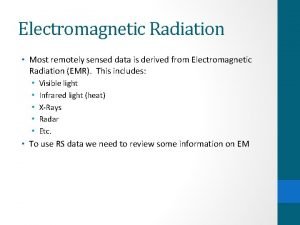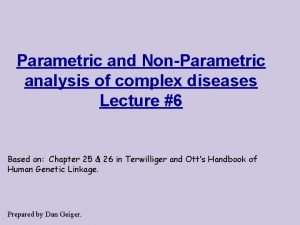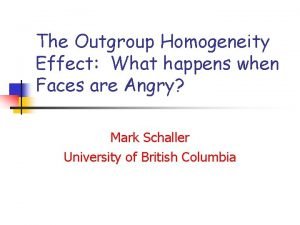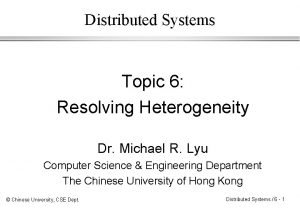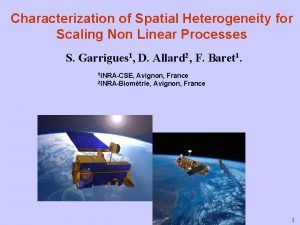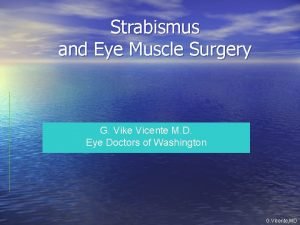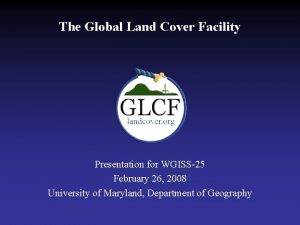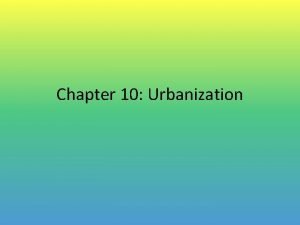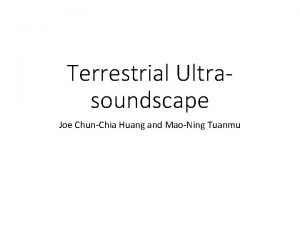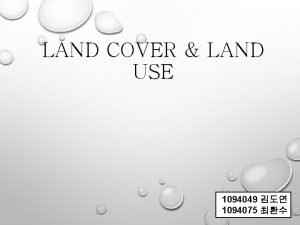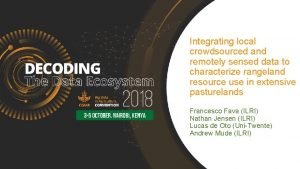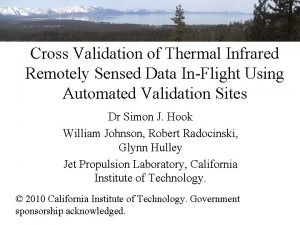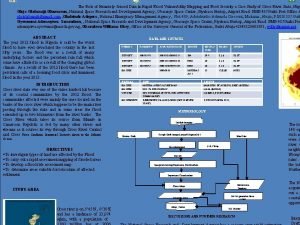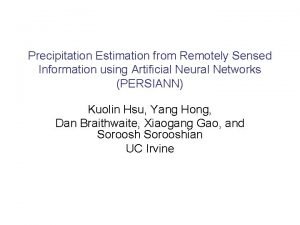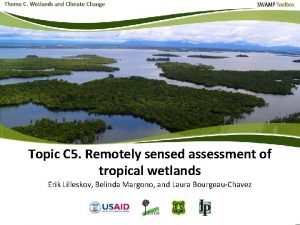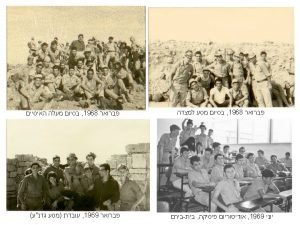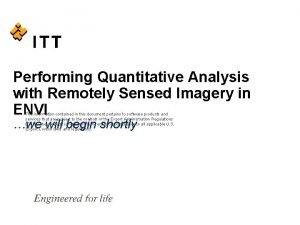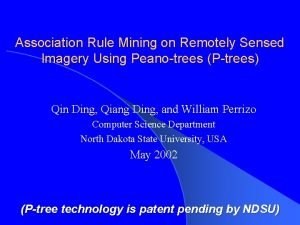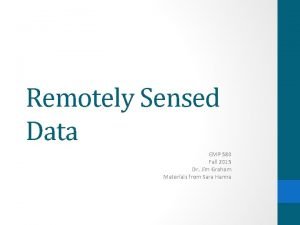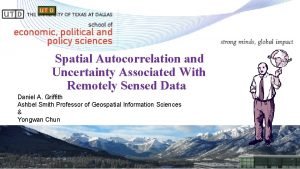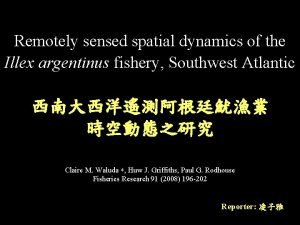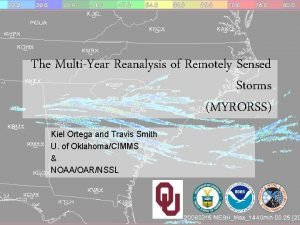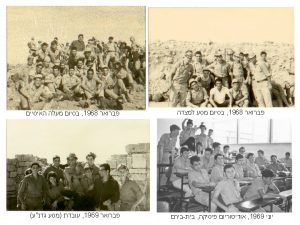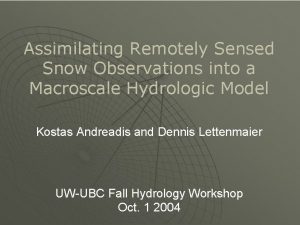Remotely sensed land cover heterogeneity MaoNing Tuanmu 5292012


















- Slides: 18

Remotely sensed land cover heterogeneity Mao-Ning Tuanmu 5/29/2012

Outline Objectives & rationale Remotely sensed data Heterogeneity metrics Calculation approaches of heterogeneity metrics • Next steps • •

Spatial heterogeneity of land cover • Species distributions and biodiversity patterns • Landscape metrics based on categorical land cover maps – Boundary delineation – Heterogeneity within a land cover type • Continuous measures of land surface characteristics from remote sensing

Objectives • To explore different approaches for quantifying land cover heterogeneity based on remotely sensed data • To generate remote sensing-based heterogeneity metrics at the global scale • To evaluate the usefulness of those metrics for explaining biodiversity patterns and monitoring their temporal dynamics

Remote Sensing Imagery • Landsat 5 TM and Landsat 7 ETM+ • Global Land Survey (GLS) surface reflectance – 7 bands, QA – Three epochs: 1990, 2005 – 7, 000~8, 000+ scenes for each epoch – 22 scenes covering the entire Oregon • Vegetation indices – NDVI

Remote Sensing-Based Metrics • First-order texture measures – Statistics calculated from image pixel values – Composition of pixel values – Average, SD, range, maximum, minimum and etc. of pixel values within a pixel neighborhood – Values of individual spectral bands – Linear or non-linear combinations of spectral bands

First-order Texture Measures Standard deviation Coefficient of variation

Remote Sensing-Based Metrics • Second-order texture measures – Statistics calculated based on values of pixel pairs – Information on the spatial relationship between two pixels – Spatial configuration (or arrangement) of pixel values – Metrics based on the Gray Level Co-occurrence Matrix (GLCM)

Gray Level Co-occurrence Matrix (GLCM) • A tabulation of how often different combinations of pixel brightness values (grey levels) occur in a pixel neighborhood • A symmetric n-by-n matrix, where n is the number of all possible gray levels (e. g. , n=16 (2^4) for a 4 -bit image) • The element Pij of a GLCM is the occurrence probability of the pixel pairs with values i and j within a pixel neighborhood

GLCM Metrics • Pixel neighborhood • Pixel pairs – Direction (0°, 90°, 45°, 135°) – Offset distance (offset = 0) • Metrics – Contrast-related • Contrast, dissimilarity, homogeneity – Orderliness-related • Angular second moment, entropy – Descriptive statistics • Mean, variance, correlation a b c d e f g h i

Second-order Texture Measures

Second-order Texture Measures

Moving Window vs. Fixed Grid • Moving window approach – Run a moving window across the entire image (study area) to calculate first- and second-order metrics for each pixel (e. g. , Landsat pixel of 30 m) – Aggregate metric values (e. g. , calculate mean and SD) for a larger regular grid (e. g. , MODIS 500 m grid) or specific area (e. g. , sampling plot) • Fixed grid approach – Directly calculate metrics based on the values of Landsat pixels within each MODIS pixel

Moving window approach (Mean of metric values in 3 x 3 windows) Approach Comparison Homogeneity Angular second moment Fixed grid approach (Metric values in MODIS 500 m grids)

Approach Comparison Moving window approach (Mean of metric values in moving windows) Standard Deviation 3 x 3 moving window 11 x 11 moving window Fixed grid approach (Metric values in MODIS 500 m grids)

Moving Window vs. Fixed Grid • Moving window approach – Texture characteristics at different grains (3 x 3, 11 x 11…) – Computation-intensive • Fixed grid approach – Texture characteristics at the scale of the fixed grid – Easier to interpret – Much less computation-intensive (> 10 times faster)

Next Steps • Comparison between texture measures and landscape metrics from categorical land cover data (NLCD) – Fragstats – Only in the Windows system – Cannot handle the entire Landsat scene with the moving window approach

Next Steps • Metrics related to spatial autocorrelation – Measures of spatial autocorrelation (e. g. , Moran’s I) – Characteristics of variogram (e. g. , sill and range) • Seasonality effects – Cropland – Mosaicked images from NASA
 Remotely sensed data
Remotely sensed data It is where dancers interact in myriad ways
It is where dancers interact in myriad ways How to access tally remotely
How to access tally remotely Heterogeneity marketing
Heterogeneity marketing Allelic heterogeneity
Allelic heterogeneity Out-group homogeneity effect example
Out-group homogeneity effect example Heterogeneity distributed systems
Heterogeneity distributed systems Savana
Savana Allelic heterogeneity
Allelic heterogeneity The outputs of managing customer heterogeneity are:
The outputs of managing customer heterogeneity are: Allelic heterogeneity
Allelic heterogeneity Latent strabismus
Latent strabismus Vike vicente
Vike vicente Harmonious arc
Harmonious arc Global land cover facility
Global land cover facility Lesson 1 urbanization
Lesson 1 urbanization An area of land largely enclosed by higher land
An area of land largely enclosed by higher land Grassland landforms
Grassland landforms Cover letter for student teaching placement
Cover letter for student teaching placement
